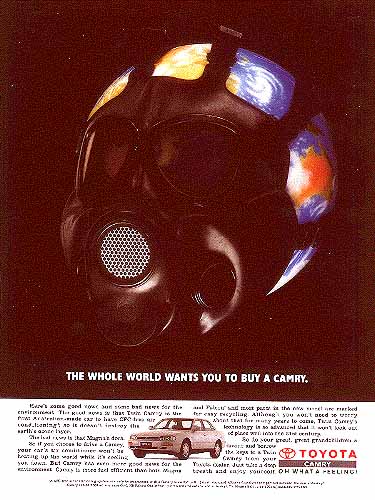 A series of media reports and books, such as The Green Consumer Guide have argued that the environment can be saved if individuals are responsible in their shopping habits and buy only environmentally sound products. The idea is that firms wanting to take advantage of this new demand for green products will change their production processes and redesign their products to meet the demand. Environmentally sound goods will become profitable.
A series of media reports and books, such as The Green Consumer Guide have argued that the environment can be saved if individuals are responsible in their shopping habits and buy only environmentally sound products. The idea is that firms wanting to take advantage of this new demand for green products will change their production processes and redesign their products to meet the demand. Environmentally sound goods will become profitable.
This view has been reinforced by commentators: "Sustainable Development means a change in consumption patterns towards environmentally more benign products, and a change in investment patterns towards augmenting environmental capital."
The other point of view on green consumerism sees the mass of consumers as being victimised and exploited by misleading advertising which appeals to highly moral, but ill-informed, instincts on environmental matters. It sees manufacturers, together with the high-priests of over-consumption, the advertising industry, adapting to environmental concerns as if they were merely a new fashion to squeeze the juice out of, before moving on.
 The rise of green consumerism in the late 1980s prompted a surge of advertisements and labels claiming environmental benefits. Green imagery was used to sell products. Caring for the environment became a marketing strategy. Often, the claims had very little substance. Greenpeace campaigners Dadd and Carothers claimed that Chevron, a multinational oil company, spent about five times as much publicising its environmental actions as it did on the actions themselves.
The rise of green consumerism in the late 1980s prompted a surge of advertisements and labels claiming environmental benefits. Green imagery was used to sell products. Caring for the environment became a marketing strategy. Often, the claims had very little substance. Greenpeace campaigners Dadd and Carothers claimed that Chevron, a multinational oil company, spent about five times as much publicising its environmental actions as it did on the actions themselves.
In 2008 a study by the Boston College Center for Corporate Citizenship found that 39 percent of Americans were buying products that they believed to be 'environmentally-friendly'.
At the same time, almost half (48 percent) of the population erroneously believe a product marketed as "green" or "environmentally friendly" has a positive (i.e., beneficial) impact on the environment. Only 22 percent understand these terms more accurately describe products with less negative environmental impact than previous versions or competing products.
The nuclear energy industry is an example of an industry that has jumped on the environmental bandwagon to improve its image. In one advertisement, the USA Council for Energy Awareness pictured a family of birds, and states, 'Every year, the ospreys return to their wildlife-preserve around the nuclear electric plant near Waterford, Connecticut, where nesting platforms have been built for them by the local utility. It's one more example of how peacefully nuclear energy coexists with the environment.' The message is that the nuclear power plant does not pollute the air or produce greenhouse gases. No mention is made of the environmental and health problems surrounding extraction of uranium, nuclear accidents or disposal of nuclear wastes.
It does not make sense to concentrate on one part of a product's life-cycle. Nor does it make sense to ignore the policies of the company that produced the product and its subsidiaries. 'Otherwise we could find that we are "voting with our purses" for manufacturers that are anti-ecological, but indirectly so.'
 Government regulation is necessary to ensure that manufacturers continue to reduce the environmental impact of all their products, not just a special green line to suit the demands of environmentally aware shoppers. If it is good for the environment for detergents to be phosphate free, then they should all be phosphate free. Where is the advantage in making this a consumer choice?
Government regulation is necessary to ensure that manufacturers continue to reduce the environmental impact of all their products, not just a special green line to suit the demands of environmentally aware shoppers. If it is good for the environment for detergents to be phosphate free, then they should all be phosphate free. Where is the advantage in making this a consumer choice?